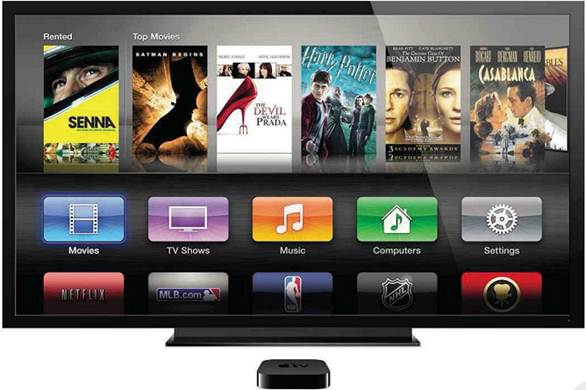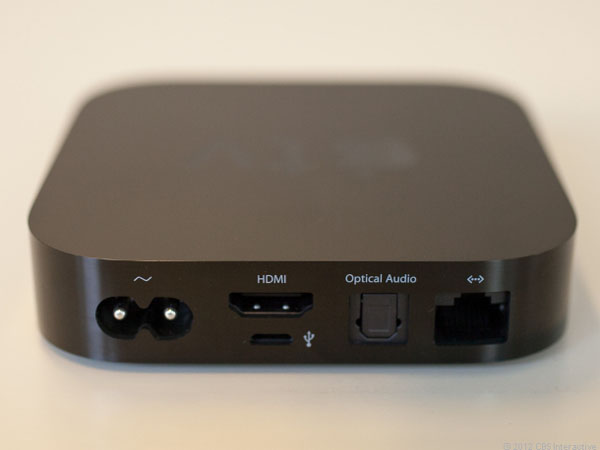There are various other ways to stream
music and video around your house. The most seamless is Airplay, Apple’s own
technology, available only for iOS devices (it’s coming to the Mac this summer
with OS X Mountain Lion). iOS includes the ability to output an Airplay audio
or video feed that can be picked up by any Airplay device. The most
sophisticated of these - yet also the cheapest, because it doesn’t include a
display or speakers of its own - is Apple TV, which connects to, logically
enough, your TV set. Only modern digital models need apply; it must have an
HDMI input.

The
most sophisticated of these - yet also the cheapest, because it doesn’t include
a display or speakers of its own - is Apple TV, which connects to, logically
enough, your TV set.
Whenever you’re playing a video or music
track in iOS - whether in the Music or Videos apps, the YouTube app, in Safari
or even in third-party apps - and your device is connected to the same Wi-Fi
network as an Apple TV, you’ll see an extra icon in the playback controls bar.
To stream what’s playing to your Apple TV, and thence your TV set (assuming its
set to the correct HDMI input), just tap this Airplay icon.
Apple TV
It’s barely the size of a paperback, but
Apple’s $154 TV box is a great investment if you want to watch iTunes movies,
TV shows or even your family photos on a big screen. You can also use it to
mirror whatever’s on your iPhone, iPad or iPod touch screen to the TV,
including some great games specially designed to work this way.
Connect the HDMI port to your digital TV,
log the Apple TV on to your Wi-Fi network using its simple on-screen menus (or
plug an Ethernet cable into the back if you have a wired network point handy),
and you can browse your Mac’s iTunes library via Home Sharing or send a live
feed from iOS via Airplay.

Connect
the HDMI port to your digital TV, log the Apple TV on to your Wi-Fi network
using its simple on-screen menus
The recently launched third-generation
model hasn’t changed much - its new icon-based user interface is also available
as an update to the previous model - but it now supports 1080p Full HD for
ultra-sharp movie and TV viewing.
Although the Apple TV isn’t a set-top box
in the conventional sense - you can’t get cable or satellite services on it,
and it doesn’t have any internal storage to record TV programs - you can use it
to rent movies and TV shows direct from the iTunes Store and access a limited
range of third-party services, including Netflix, YouTube and Video. There’s no
support yet for BBC iPlayer or the other UK TV networks’ online services. We
reckon it makes the most sense as a gateway from your Mac and iOS devices to
your TV set, and as such it’s brilliantly simple to use.
The remote app
(The first time you do this, you’ll need
to make sure you’ve set up Home Sharing with your Apple ID.) It really is that
simple - there’s no messy configuration. The only wrinkle is that your Wi-Fi
reception and router performance will need to be up to scratch to stream HD
video.
You can also mirror the iOS display to the
TV at any time. If there’s no Airplay icon visible, double-tap the Home button
and swipe the row of icons at the foot of the screen all the way to the right
to reveal the default media playback controls; there should also be an Airplay
icon here. Tap it and select Apple TV and Mirror. As the term suggests, you’ll
normally see exactly what’s on your screen on the TV (in the orientation you’re
using), but some apps, such as Airplay- equipped games, will output a dedicated
TV feed instead, generally in 720p or 1080p HD.

Free play-Cover art is shown while your media plays, but you can switch away
from this to browse other content or do something else entirely without
affecting playback
Although OS X can’t yet send media from a
Mac to an Apple TV via Airplay, the Apple TV can pull it from the Mac via Home
Sharing. Click Computers to see your shared libraries. The Apple TV has no
storage capacity of its own, but you can effectively use your Mac as its content
repository.
Third party apps such as Air Server
(airserverapp.com) bring additional Airplay features to iOS and OS X, enabling
you to stream between devices even if you don’t have an Apple TV.
Streaming music is equally straightforward.
Apple doesn’t make an Airplay speaker, but plenty of other companies do. You
can also stream to an AirPort Express ($123 from the Apple Store), the handy
wireless network extender/adaptor that also happens to have an audio output
jack. Typically, people use this to stream music around the house: connect the
AirPort Express to a hi-fi using a mini jack to jack or phonon cable, then in
iTunes in OS X, select the hi-fi as a destination.